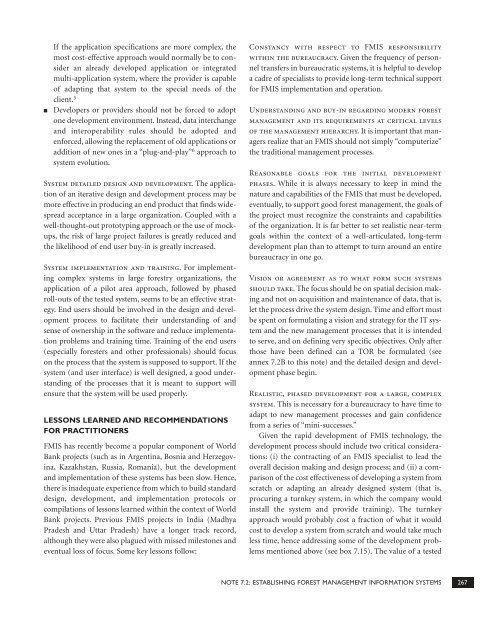Forests Sourcebook - HCV Resource Network
Forests Sourcebook - HCV Resource Network
Forests Sourcebook - HCV Resource Network
Create successful ePaper yourself
Turn your PDF publications into a flip-book with our unique Google optimized e-Paper software.
■<br />
If the application specifications are more complex, the<br />
most cost-effective approach would normally be to consider<br />
an already developed application or integrated<br />
multi-application system, where the provider is capable<br />
of adapting that system to the special needs of the<br />
client. 5<br />
Developers or providers should not be forced to adopt<br />
one development environment. Instead, data interchange<br />
and interoperability rules should be adopted and<br />
enforced, allowing the replacement of old applications or<br />
addition of new ones in a “plug-and-play” 6 approach to<br />
system evolution.<br />
System detailed design and development. The application<br />
of an iterative design and development process may be<br />
more effective in producing an end product that finds widespread<br />
acceptance in a large organization. Coupled with a<br />
well-thought-out prototyping approach or the use of mockups,<br />
the risk of large project failures is greatly reduced and<br />
the likelihood of end user buy-in is greatly increased.<br />
System implementation and training. For implementing<br />
complex systems in large forestry organizations, the<br />
application of a pilot area approach, followed by phased<br />
roll-outs of the tested system, seems to be an effective strategy.<br />
End users should be involved in the design and development<br />
process to facilitate their understanding of and<br />
sense of ownership in the software and reduce implementation<br />
problems and training time. Training of the end users<br />
(especially foresters and other professionals) should focus<br />
on the process that the system is supposed to support. If the<br />
system (and user interface) is well designed, a good understanding<br />
of the processes that it is meant to support will<br />
ensure that the system will be used properly.<br />
LESSONS LEARNED AND RECOMMENDATIONS<br />
FOR PRACTITIONERS<br />
FMIS has recently become a popular component of World<br />
Bank projects (such as in Argentina, Bosnia and Herzegovina,<br />
Kazakhstan, Russia, Romania), but the development<br />
and implementation of these systems has been slow. Hence,<br />
there is inadequate experience from which to build standard<br />
design, development, and implementation protocols or<br />
compilations of lessons learned within the context of World<br />
Bank projects. Previous FMIS projects in India (Madhya<br />
Pradesh and Uttar Pradesh) have a longer track record,<br />
although they were also plagued with missed milestones and<br />
eventual loss of focus. Some key lessons follow:<br />
Constancy with respect to FMIS responsibility<br />
within the bureaucracy. Given the frequency of personnel<br />
transfers in bureaucratic systems, it is helpful to develop<br />
a cadre of specialists to provide long-term technical support<br />
for FMIS implementation and operation.<br />
Understanding and buy-in regarding modern forest<br />
management and its requirements at critical levels<br />
of the management hierarchy. It is important that managers<br />
realize that an FMIS should not simply “computerize”<br />
the traditional management processes.<br />
Reasonable goals for the initial development<br />
phases. While it is always necessary to keep in mind the<br />
nature and capabilities of the FMIS that must be developed,<br />
eventually, to support good forest management, the goals of<br />
the project must recognize the constraints and capabilities<br />
of the organization. It is far better to set realistic near-term<br />
goals within the context of a well-articulated, long-term<br />
development plan than to attempt to turn around an entire<br />
bureaucracy in one go.<br />
Vision or agreement as to what form such systems<br />
should take. The focus should be on spatial decision making<br />
and not on acquisition and maintenance of data, that is,<br />
let the process drive the system design. Time and effort must<br />
be spent on formulating a vision and strategy for the IT system<br />
and the new management processes that it is intended<br />
to serve, and on defining very specific objectives. Only after<br />
those have been defined can a TOR be formulated (see<br />
annex 7.2B to this note) and the detailed design and development<br />
phase begin.<br />
Realistic, phased development for a large, complex<br />
system. This is necessary for a bureaucracy to have time to<br />
adapt to new management processes and gain confidence<br />
from a series of “mini-successes.”<br />
Given the rapid development of FMIS technology, the<br />
development process should include two critical considerations:<br />
(i) the contracting of an FMIS specialist to lead the<br />
overall decision making and design process; and (ii) a comparison<br />
of the cost effectiveness of developing a system from<br />
scratch or adapting an already designed system (that is,<br />
procuring a turnkey system, in which the company would<br />
install the system and provide training). The turnkey<br />
approach would probably cost a fraction of what it would<br />
cost to develop a system from scratch and would take much<br />
less time, hence addressing some of the development problems<br />
mentioned above (see box 7.15). The value of a tested<br />
NOTE 7.2: ESTABLISHING FOREST MANAGEMENT INFORMATION SYSTEMS 267

















